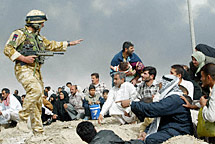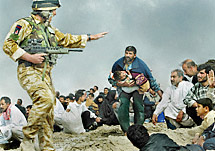Accuracy, context, cultural sensitivity, and an awareness of how things can go wrong are part of an ethical approach to using images.

On June 12, 2020, Fox television took down this and several other digitally manipulated images that made civil protests look like riots in June 2020. Fox claimed it was a simple error, but it was clearly unethical.
Codes of professional ethics condemn this sort of news manipulation, as follows:
- National Press Photographers Code of Ethics Editing should maintain the integrity of the photographic images’ content and context. Do not manipulate images or add or alter sound in any way that can mislead viewers or misrepresent subjects.”
- Associated Press. AP pictures must always tell the truth. We do not alter or manipulate the content of a photograph in any way. The content of a photograph must not be altered in PhotoShop or by any other means. No element should be digitally added to or subtracted from any photograph. The faces or identities of individuals must not be obscured by PhotoShop or any other editing tool. Only retouching or the use of the cloning tool to eliminate dust and scratches are acceptable. Minor adjustments in PhotoShop are acceptable… (but) … Changes in density, contrast, color and saturation levels that substantially alter the original scene are not acceptable. Backgrounds should not be digitally blurred or eliminated by burning down or by aggressive toning.
- Reuters: No additions or deletions to the subject matter of the original image. (thus changing the original content and journalistic integrity of an image). No excessive lightening, darkening or blurring of the image (thus misleading the viewer by disguising certain elements of an image). No excessive colour manipulation. (thus dramatically changing the original lighting conditions of an image). Only minor Photoshop work should be performed in the field (especially from laptops). We require only cropping, sizing and levels with resolution set to 300 dpi. Where possible, ask your regional or global picture desks to perform any required further Photo-shopping on their calibrated hi-resolution screens…
- Photographer’s Guide to Privacy by the Reporters Committee for Freedom of the Press
PHOTO MANIPULATION
Photo manipulation presents us with ethical dilemmas of varying degrees of severity. In some cases, the photographers or editors are fired when unethical images are used. In other cases, such as this magazine cover from the Economist, the ethical issue is debatable.
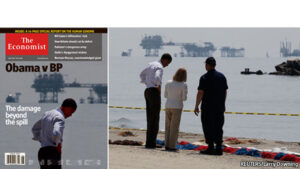 The Economist magazine, 2010, isolated then president Barack Obama in a cover photo. |
||
Volkswagen ad, 2020
|
||
| Volkswagen’s racist ad from May 2020 “horrified” management when they realized what their agency had done. A company official apologized and called it “an insult to every decent person.” The 10-second clip depicted a pair of oversize white hands dragging a black man away from a new VW Golf 8 sedan, and flicking him violently into a restaurant called “Petit Colon,” a name with overtones of colonization. Briefly as a spokeswoman reads the phrase “Der Neue Golf,” or “the new Golf,” as it appears on the screen, the letters materialize in an order that briefly spells the German n-word. | ||
ASIANA FLIGHT 214 Racism and racial slurs are deeply objectionable. Reporting on the crash of Asiana flight 214 in the summer of 2013, TV news reporters were fooled into using names of the crew that included “Sum Ting Wong, Wi Tu Lo, Ho Lee Fuk, and Bang Ding Ow.” |
||
Yom Kippur coverage 2015 Another highly insensitive media faux-pas, if not ethical outrage, was this use of a Nazi concentration camp emblem as an illustration for a 2015 story about the Jewish holiday Yom Kippur. |
||
| HURRICANE KATRINA 2005 | ||
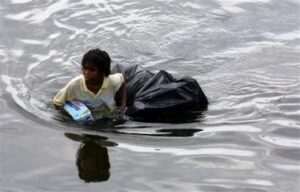 A young man walks through chest deep flood water after looting a grocery store in New Orleans on Tuesday, Aug. 30, 2005. Flood waters continue to rise in New Orleans after Hurricane Katrina did extensive damage when it made landfall on Monday. (AP Photo/Dave Martin) |
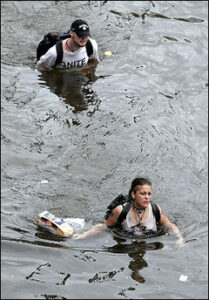 Two residents wade through chest-deep water after finding bread and soda from a local grocery store after Hurricane Katrina came through the area in New Orleans, Louisiana.(AFP/Getty Images/Chris Graythen) |
|
OJ SIMPSON. NEWSWEEK AND TIME, 1994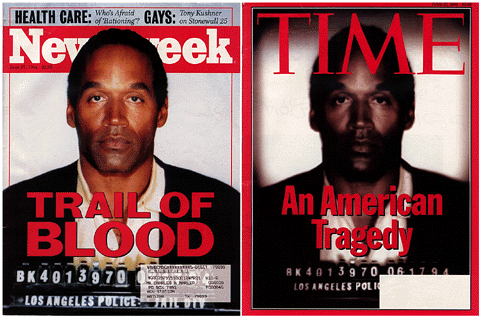 Did Time Magazine act unethically when it darkened the face of OJ Simpson to make him seem more sinister? |
||
MUG SHOTS IN IOWA, 2015
|
||
Kent State 1970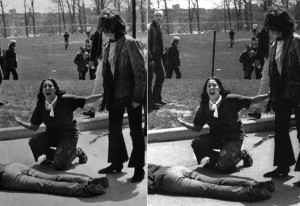 This 1970 Pulitzer-prize winning photo by John Filo depicts Mary Ann Vecchio at the Kent State Campus reacting just after National Guard troops killed 20-year-old Jeffrey Miller. The version on the right, with the apparent “merger” of a fence post with the top of Vecchio’s head, is actually the original. The version on the left has the fence post airbrushed out, which is not ethical in a news photo.
|
||
IRAQ 2003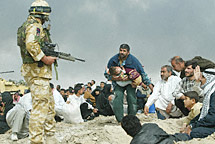 This first photo is the composite, in which a soldier appears to be telling a man with a child to sit. The two photos from which this is drawn tell a different story. The photographer responsible for these photos was dismissed from the LA Times two days after the composites came to light. LA TIMES, Basra, 2003
|
||
Artificial intelligence and ethics
Copyright and Artificial IntelligenceWhen artificial intelligence went public in 2022 – 23, the possibilities were not clear. However, one of the concerns has been that AI uses “large language models had to train on content scraped from the web — without the consent of artists and writers. One Author’s Guild lawsuit for copyright infringement was filed Sept. 23 , 2023 (brief here). Another LLM lawsuit filed by the New York Times in December 2023 also alleges that LLMs training on Times news articles violate the newspaper’s copyright. See Times articles here, here and the Verge here. The actual complaint of Dec. 27 can be seen here. AI companies say their datasets and models are protected by the “fair use” exception to copyright law, according to an October, 2023 Columbia Journalism Review article,
Generative AI presents a unique set of opportunities and challenges to creative industries, said FTC Commission chair Lena Khan in a roundtable discussion Oct. 3, 2023 (transcript here). One significant point, she noted: “All of the laws that already prohibit unfair methods of competition or collusion or discrimination or deception — all of those laws still entirely apply” (to AI). Also see Copyright office statement on AI, November 2023
|

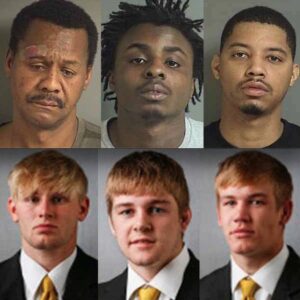 Racism is often built into the crime reporting system. Take for example the selection of mug shots to illustrate arrest stories. In March of 2015, the Cedar Rapids Iowa Gazette newspaper reported on two groups of people who were arrested for two burglaries. The police mug shots of one group were posted, while yearbook pictures were posted for the other group. After this comparison showed up in social media, the Gazette went back to the police department and got the mug shots for the second group
Racism is often built into the crime reporting system. Take for example the selection of mug shots to illustrate arrest stories. In March of 2015, the Cedar Rapids Iowa Gazette newspaper reported on two groups of people who were arrested for two burglaries. The police mug shots of one group were posted, while yearbook pictures were posted for the other group. After this comparison showed up in social media, the Gazette went back to the police department and got the mug shots for the second group